The quest to create robots that can learn and adapt like humans represents one of the most fascinating frontiers in artificial intelligence research. Unlike traditional robots programmed with explicit instructions for specific tasks, today’s advanced systems are being designed to observe, adapt, and improve through experience—mirroring the fundamental learning processes that humans naturally employ. This shift from rigid programming to flexible, autonomous learning is revolutionizing how robots interact with the world and opening new possibilities across industries.
AI systems now enable robots to learn by observing human demonstrations, similar to how humans learn from one another.
As we venture deeper into this technological revolution, the line between human and machine learning continues to blur. Modern AI approaches are teaching robots to not just execute tasks but to understand the underlying principles, adapt to new situations, and even improve their performance through trial and error—capabilities once thought to be exclusively human. This article explores the mechanisms, challenges, and future implications of this remarkable convergence of artificial intelligence and human-like learning in robotics.
The Mechanisms Behind AI-Powered Learning in Robots
At the core of teaching robots to learn like humans are sophisticated AI mechanisms that mimic neural processes. These systems enable machines to process information, recognize patterns, and adapt their behaviors based on experience—much like the human brain.
Neural Networks: The Digital Brain
Neural networks serve as the foundation for human-like learning in robots. These computational models are inspired by the structure and function of the human brain, consisting of interconnected nodes (neurons) that process and transmit information.
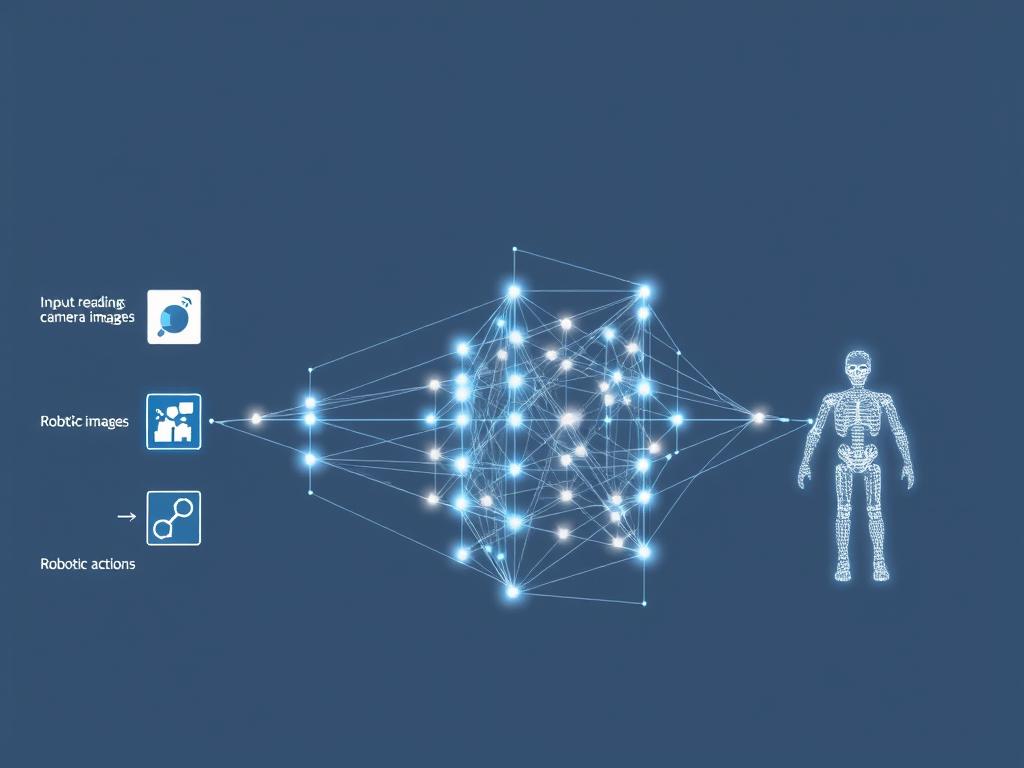
Neural networks process sensory inputs and translate them into robotic actions, forming the basis of machine learning in robotics.
Deep learning, a subset of neural networks with multiple layers, enables robots to automatically learn hierarchical features from data. This architecture has led to significant breakthroughs in image and speech recognition—critical capabilities for robots that need to perceive and interact with their environment.
“The recent advancements in deep learning have enabled robots to process visual information in ways that were unimaginable just a decade ago. They can now recognize objects, understand spatial relationships, and even predict movement patterns—all essential components of human-like learning.”
Reinforcement Learning: Trial and Error
Reinforcement learning represents another crucial mechanism for teaching robots human-like learning capabilities. This approach enables robots to learn through trial and error, similar to how humans learn from the consequences of their actions.
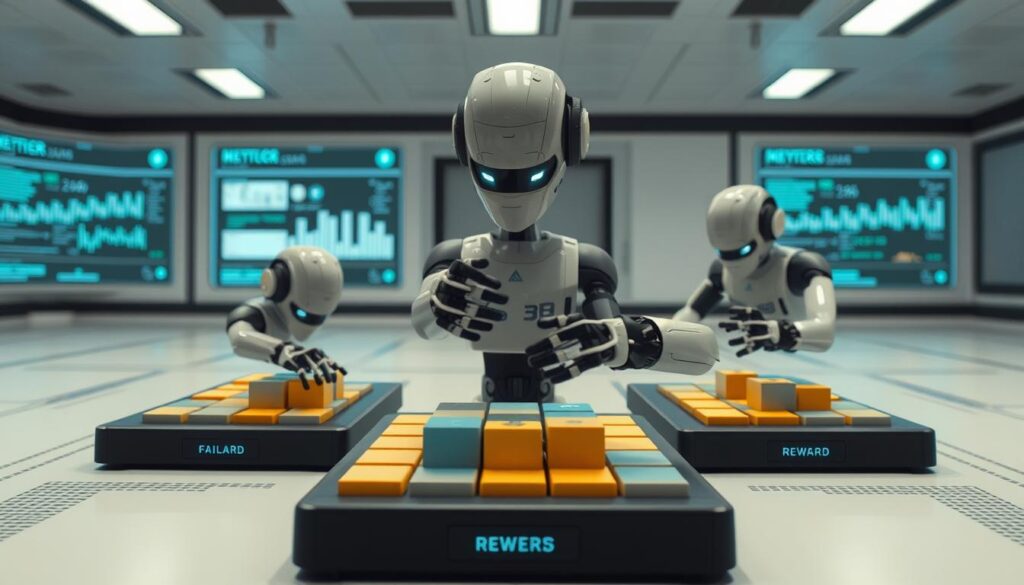
Through reinforcement learning, robots improve their performance by receiving rewards for successful actions and penalties for failures.
In reinforcement learning, robots receive rewards for successful actions and penalties for failures. Over time, they develop strategies to maximize rewards, effectively learning optimal behaviors without explicit programming. This approach has proven particularly effective for teaching robots complex tasks like object manipulation and navigation in dynamic environments.
Case Study: OpenAI’s Dactyl
OpenAI’s Dactyl project demonstrates the power of reinforcement learning in robotics. Researchers trained a robotic hand to manipulate objects with unprecedented dexterity by using a technique called domain randomization, which exposes the AI to countless virtual scenarios.

OpenAI’s Dactyl learned to manipulate objects with human-like dexterity through millions of simulated trials.
What makes Dactyl remarkable is that the system was trained entirely in simulation but could successfully transfer its learning to the physical world. The robot learned to adapt to various conditions, including different object sizes, weights, and textures—demonstrating a level of adaptability previously unseen in robotic systems.
Human Learning Parallels in Robotic Systems
Beyond neural networks and reinforcement learning, researchers are implementing additional learning mechanisms that closely parallel human cognitive development. These approaches further bridge the gap between human and machine learning processes.
Imitation Learning: Learning by Watching
Imitation learning represents one of the most intuitive parallels to human learning in robotic systems. This approach enables robots to learn by observing and replicating human actions, similar to how children learn by watching adults.
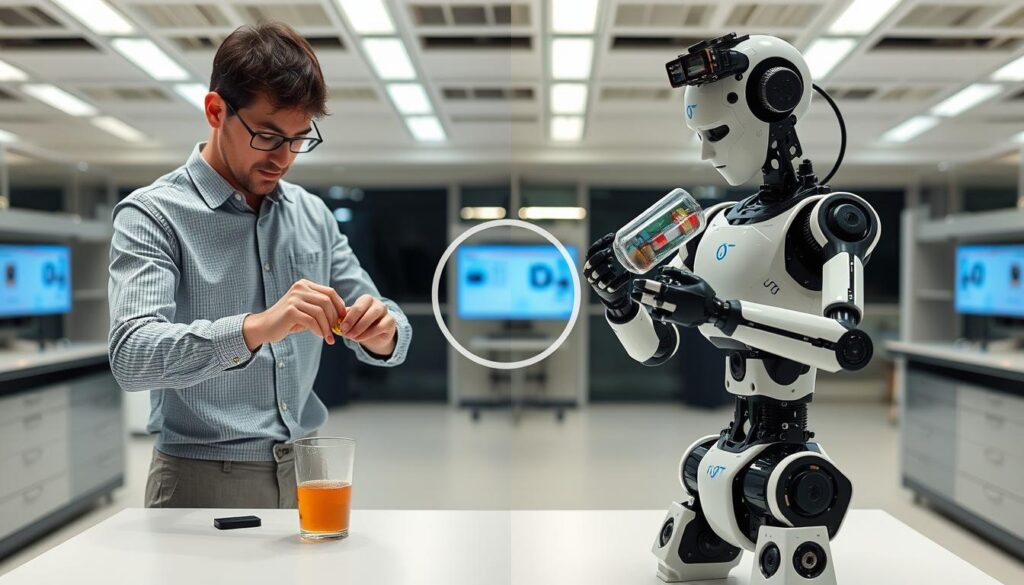
Through imitation learning, robots observe human demonstrations and replicate the actions, accelerating the learning process.
Using cameras and sensors, robots capture and analyze human movements, then translate these observations into their own actions. This approach has proven particularly effective for teaching robots complex manipulation tasks that would be difficult to program explicitly.
Google DeepMind has pioneered this field with its virtual playground called GoalCycle3D. In this environment, AI agents learn in real-time by observing expert demonstrations, then applying this knowledge to navigate through courses independently. The system employs predictive focus and memory modules to facilitate this learning process.
“Imitation learning represents a fundamental shift in how we approach robotics. Instead of programming every possible scenario, we’re teaching robots to learn from demonstration—just as humans do. This dramatically accelerates the learning process and enables robots to acquire skills that would be nearly impossible to program explicitly.”
Meta-Learning: Learning How to Learn
Meta-learning—or “learning to learn”—represents another fascinating parallel to human cognition. This approach enables robots to become more efficient learners over time by understanding the underlying structure of learning problems.
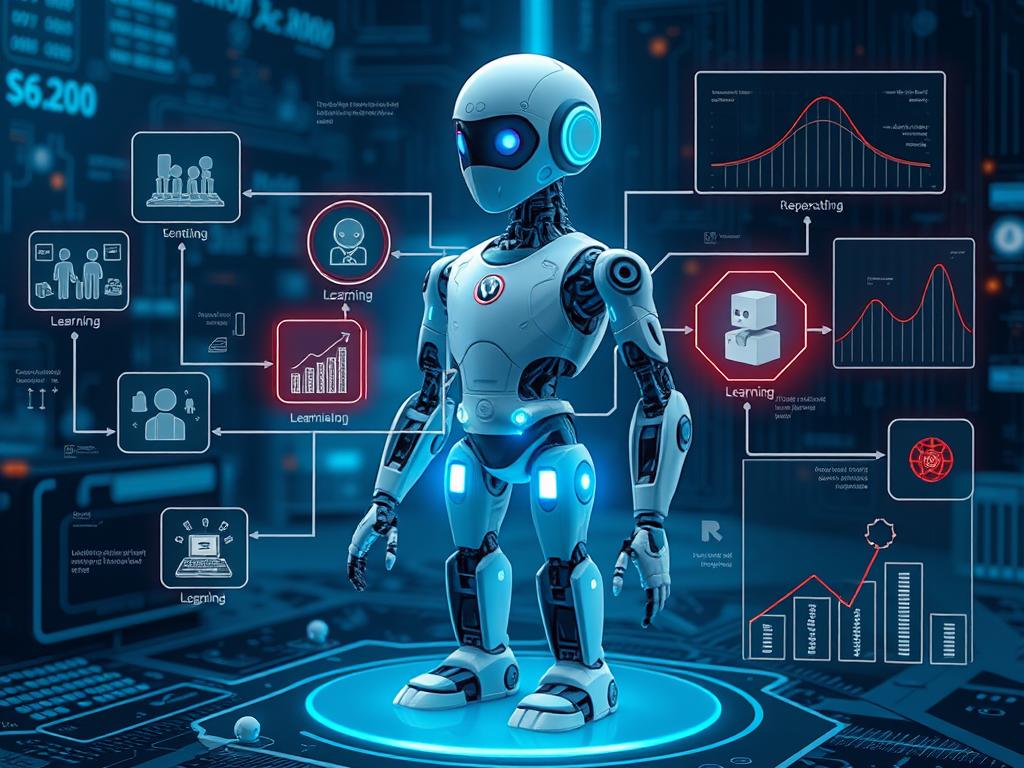
Meta-learning enables robots to adapt their learning strategies based on previous experiences, becoming more efficient learners over time.
Through meta-learning, robots develop the ability to quickly adapt to new tasks based on previous learning experiences. This capability is particularly valuable in dynamic environments where robots encounter novel situations requiring rapid adaptation.
Boston Dynamics’ Atlas: Physical Learning
Boston Dynamics’ Atlas robot exemplifies physical learning capabilities that parallel human motor skill development. Through a combination of reinforcement learning and simulation, Atlas has mastered complex movements like parkour, backflips, and dance routines.
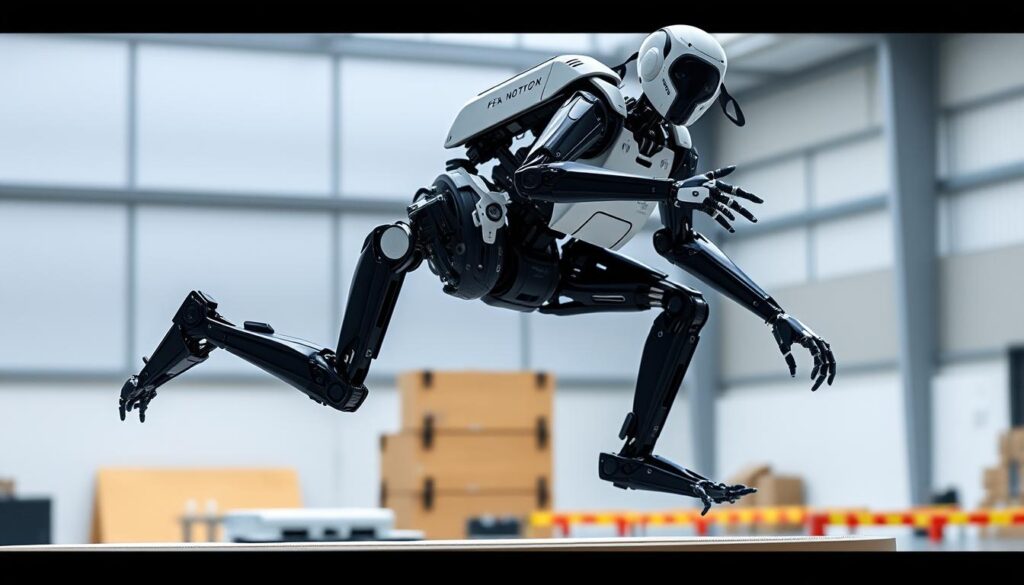
Boston Dynamics’ Atlas robot has learned complex physical movements through advanced AI learning techniques.
What makes Atlas remarkable is its ability to adapt to physical challenges in real-time. The robot can recover from slips, adjust to different surfaces, and maintain balance during complex maneuvers—demonstrating a level of physical intelligence that closely resembles human capabilities.
Explore Advanced Robotics Research
Want to dive deeper into the latest developments in AI-powered robotics? Access our comprehensive research library featuring case studies, technical papers, and expert analyses.
Challenges in Teaching Robots Human-Like Learning
Despite remarkable progress, teaching robots to learn like humans presents significant challenges that researchers continue to address. These obstacles span technical, ethical, and practical domains.
Data Limitations and Quality
Human-like learning in robots requires vast amounts of high-quality data. Unlike humans who can learn from limited examples, AI systems typically need extensive datasets to develop robust capabilities.
The challenge extends beyond quantity to quality and diversity. Robots need exposure to varied scenarios to develop generalizable knowledge rather than overfitting to specific conditions. This is particularly challenging for physical tasks where collecting diverse real-world data can be time-consuming and expensive.
Computational Costs
The computational resources required for advanced AI learning in robotics are substantial. Training sophisticated neural networks and reinforcement learning models often demands specialized hardware and significant energy consumption.
These computational costs can limit accessibility and scalability, particularly for smaller research teams or companies. As models become more complex to achieve human-like learning capabilities, managing these computational demands becomes increasingly challenging.
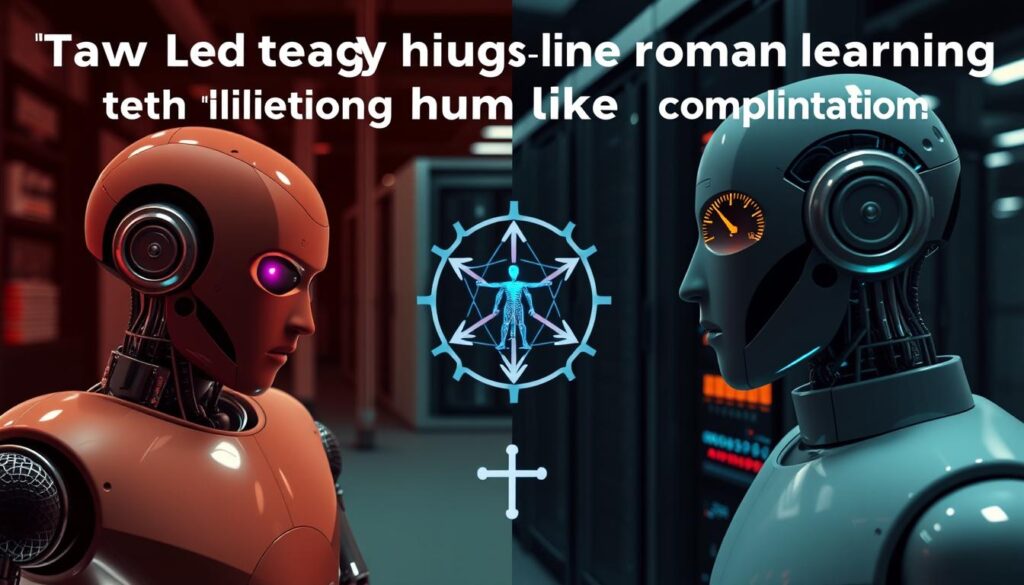
Researchers face multiple challenges in developing human-like learning capabilities in robots, including data limitations, computational costs, and ethical considerations.
Ethical Considerations and Safety
As robots become more capable of autonomous learning, ethical considerations become increasingly important. Questions about responsibility, safety, and appropriate applications require careful consideration.
Benefits of Autonomous Learning
- Adaptability to new environments and tasks
- Reduced need for explicit programming
- Potential for continuous improvement
- Ability to handle unexpected situations
- More natural human-robot interaction
Concerns About Autonomous Learning
- Unpredictable behaviors and outcomes
- Difficulty in verifying safety guarantees
- Potential for reinforcing biases in training data
- Questions about responsibility for robot actions
- Privacy implications of observational learning
Researchers are developing frameworks for responsible AI development that address these concerns while enabling progress in human-like learning capabilities. These frameworks include rigorous testing protocols, transparency requirements, and mechanisms for human oversight.
The Reality Gap
The “reality gap” refers to the challenge of transferring learning from simulated environments to the real world. While simulations offer safe, controlled spaces for robots to learn, real-world conditions introduce complexities that are difficult to model accurately.
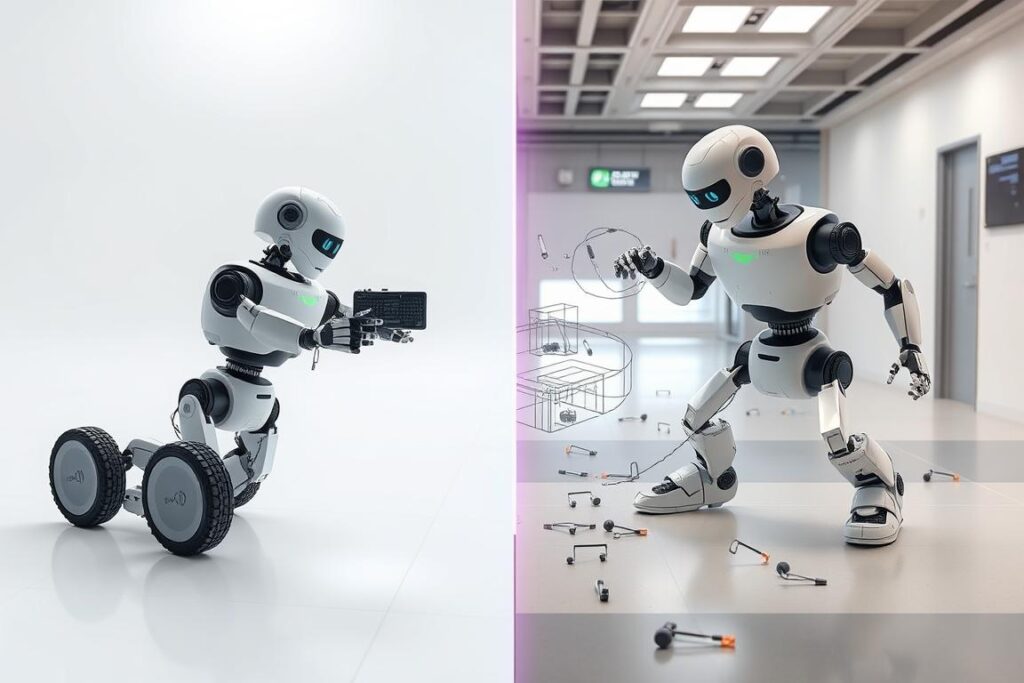
The “reality gap” presents a significant challenge when transferring robot learning from simulated environments to real-world conditions.
Bridging this gap requires techniques like domain randomization, which intentionally varies simulation parameters to prepare robots for real-world variability. Researchers are also exploring hybrid approaches that combine simulation-based pre-training with real-world fine-tuning to achieve more robust learning outcomes.
Future Implications of Human-Like Learning in Robotics
As AI continues to advance robots’ ability to learn like humans, the implications span numerous industries and aspects of society. These developments promise to transform how we work, live, and interact with technology.
Healthcare Applications
In healthcare, robots with human-like learning capabilities are poised to revolutionize patient care, surgical procedures, and medical research. These systems can learn from observing medical professionals and continuously improve their capabilities.

Medical robots with human-like learning capabilities can master complex surgical techniques and adapt to individual patient needs.
Surgical robots like Intuitive Surgical’s da Vinci system are already incorporating machine learning to enhance precision and adaptability. Future systems will likely learn from thousands of procedures to identify optimal techniques for specific conditions and patient anatomies.
Beyond surgery, care robots are being developed to learn patient preferences and needs through observation and interaction. These systems could help address healthcare worker shortages while providing personalized care, particularly for aging populations.
Manufacturing and Industry
The manufacturing sector stands to benefit significantly from robots with human-like learning capabilities. These systems can master complex assembly tasks, adapt to production changes, and work safely alongside human workers.
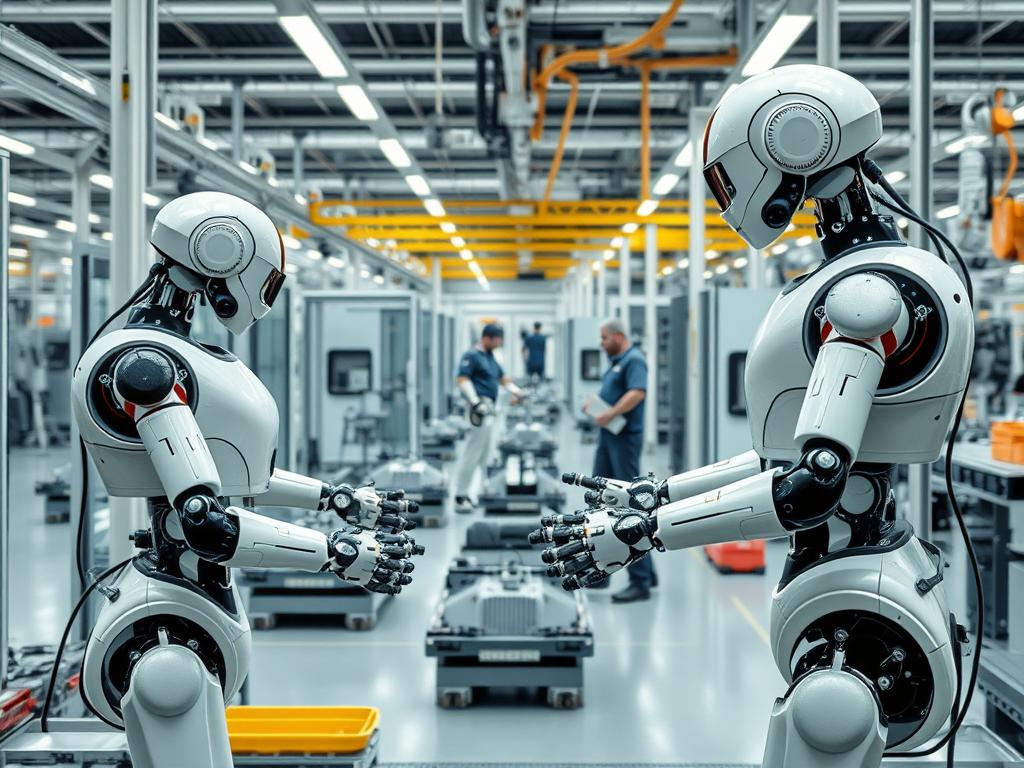
Manufacturing robots that learn through observation can quickly adapt to new products and production processes.
Companies like Fanuc are developing robots that can learn assembly tasks through demonstration rather than explicit programming. This capability dramatically reduces setup time for new production lines and enables greater flexibility in manufacturing processes.
“The future of manufacturing lies in adaptive robots that can learn new tasks quickly and work collaboratively with humans. These systems will transform production from rigid, pre-programmed processes to flexible, responsive operations that can adapt to changing market demands.”
Education and Training
In education, robots with human-like learning capabilities are being developed to serve as tutors, teaching assistants, and learning companions. These systems can adapt their teaching approaches based on student responses and learning patterns.
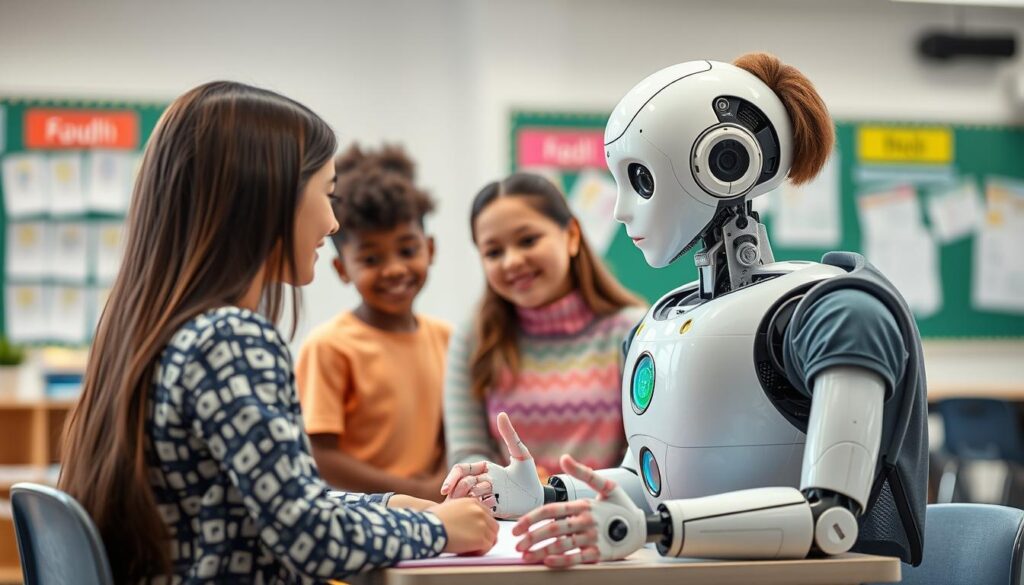
Educational robots can adapt their teaching methods to individual student needs, providing personalized learning experiences.
Japan has been at the forefront of this application, with over 500 classrooms employing AI-assisted robots to teach English. These systems observe student engagement and comprehension, adjusting their teaching strategies accordingly.
Beyond traditional education, training robots are being developed for professional skills development. These systems can demonstrate techniques, observe learner attempts, and provide personalized feedback—potentially transforming how we acquire complex skills across various domains.
Stay Updated on AI Robotics Advancements
Join our newsletter to receive the latest research, case studies, and insights on how AI is transforming robotic learning capabilities across industries.
Challenges and Ethical Considerations
As robots become increasingly capable of human-like learning, important ethical questions and challenges emerge that require careful consideration from researchers, policymakers, and society at large.
Job Displacement and Economic Impact
The advancement of robots with human-like learning capabilities raises concerns about potential job displacement. McKinsey has predicted that as many as 50% of all human jobs could be lost to robots and automation by 2050.
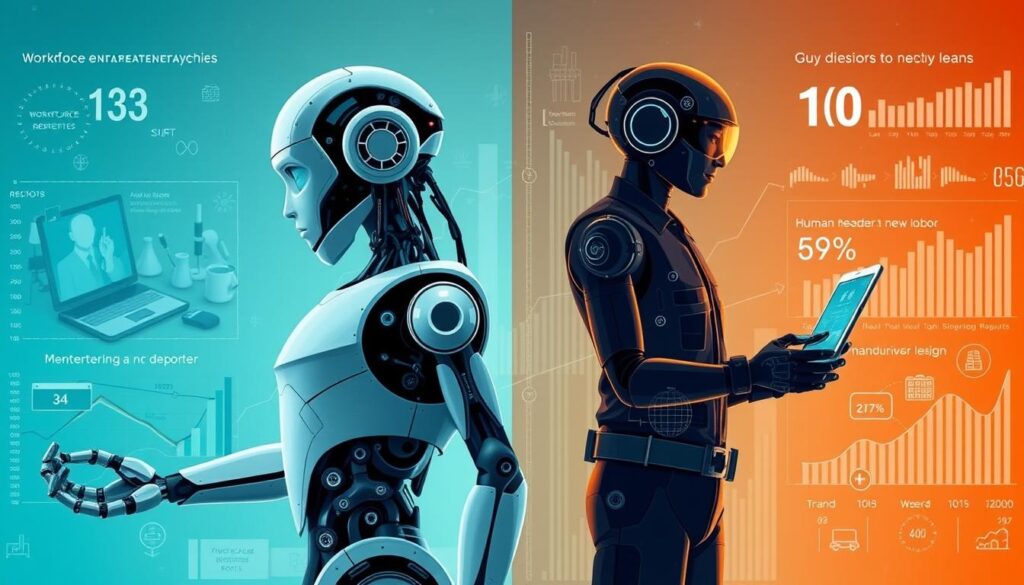
The advancement of learning robots will transform the workforce, eliminating some jobs while creating new opportunities in robot design, maintenance, and supervision.
However, history suggests that technological revolutions typically create new types of jobs even as they eliminate others. The challenge lies in managing this transition through education, retraining programs, and potentially new social policies that ensure the benefits of automation are broadly shared.
Safety and Reliability
As robots learn more autonomously, ensuring their safety and reliability becomes increasingly complex. Unlike traditional systems with predictable, programmed behaviors, learning robots may develop unexpected approaches to problems.
| Safety Challenge | Traditional Approach | Learning Robot Approach |
| Predictability | Behaviors explicitly programmed and verified | Behaviors emerge from learning process, requiring extensive testing |
| Error handling | Predefined responses to anticipated errors | Adaptive responses based on past experiences and context |
| Verification | Code review and systematic testing | Statistical performance evaluation across diverse scenarios |
| Updates | Manual software updates with controlled deployment | Continuous learning that may alter behavior over time |
Researchers are developing new approaches to safety verification for learning systems, including constrained learning environments, human oversight mechanisms, and formal verification methods for neural networks. These approaches aim to harness the benefits of adaptive learning while maintaining safety guarantees.
Privacy and Data Concerns
Robots that learn through observation necessarily collect vast amounts of data about their environments and the people within them. This raises important privacy considerations, particularly for robots deployed in sensitive settings like homes, schools, and healthcare facilities.
Addressing these concerns requires thoughtful data governance policies, transparency about data collection and use, and mechanisms for user control over personal information. As robots become more integrated into daily life, establishing appropriate privacy frameworks becomes increasingly important.
Conclusion: Balancing Progress and Responsibility
The development of robots with human-like learning capabilities represents one of the most exciting frontiers in artificial intelligence research. By mimicking the fundamental learning processes that humans employ—observation, imitation, trial and error, and adaptation—these systems are achieving unprecedented levels of flexibility and capability.
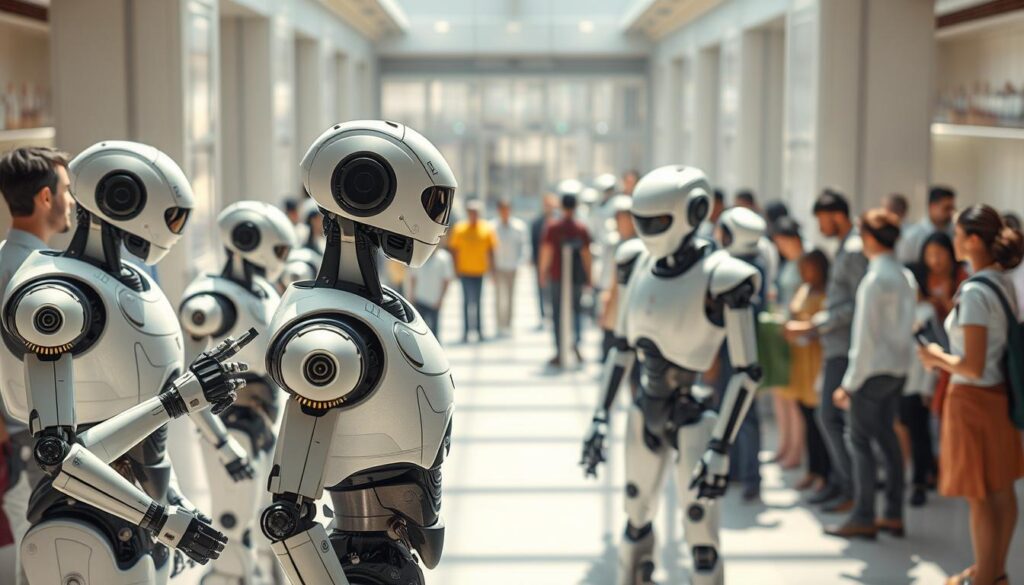
The future of robotics lies in systems that can learn, adapt, and collaborate effectively with humans across diverse environments and applications.
From healthcare and manufacturing to education and beyond, the applications of these technologies promise to transform numerous aspects of society. The ability of robots to learn from demonstration, adapt to new situations, and improve through experience opens possibilities that were once confined to science fiction.
However, realizing this potential requires addressing significant challenges. Technical hurdles like the reality gap and computational demands continue to require innovative solutions. Equally important are the ethical, economic, and social considerations that accompany these advances—from job displacement concerns to questions about safety, privacy, and appropriate use.
The path forward lies in thoughtful development that balances technological progress with responsible implementation. By addressing these challenges proactively and inclusively, we can harness the remarkable potential of human-like learning in robots while ensuring that these technologies serve human needs and values.
Explore the Future of AI in Robotics
Interested in learning more about how AI is revolutionizing robotic learning? Download our comprehensive guide featuring expert insights, case studies, and future projections.
Frequently Asked Questions
How is AI teaching robots to learn differently from traditional programming?
Traditional robot programming involves explicitly coding every action and response, creating rigid systems that can only perform specific predefined tasks. In contrast, AI teaching approaches enable robots to learn from data, experience, and observation—similar to how humans learn. This allows robots to adapt to new situations, improve their performance over time, and even develop capabilities that weren’t explicitly programmed.
What are the main techniques used for teaching robots human-like learning?
The main techniques include neural networks (particularly deep learning), which process information similar to the human brain; reinforcement learning, where robots learn through trial and error based on rewards and penalties; imitation learning, where robots observe and replicate human actions; and meta-learning, where robots learn how to learn more efficiently over time. These approaches are often combined to create more sophisticated learning systems.
How close are we to robots that truly learn like humans?
While significant progress has been made, robots still don’t learn exactly like humans. Current systems excel at specific types of learning but lack the generalized learning capabilities that humans possess. Robots can now learn complex physical tasks, recognize patterns, and adapt to certain changes in their environment, but they don’t yet have the intuitive understanding, creativity, or emotional intelligence that characterizes human learning. The field continues to advance rapidly, however, with new breakthroughs regularly pushing the boundaries of what’s possible.







